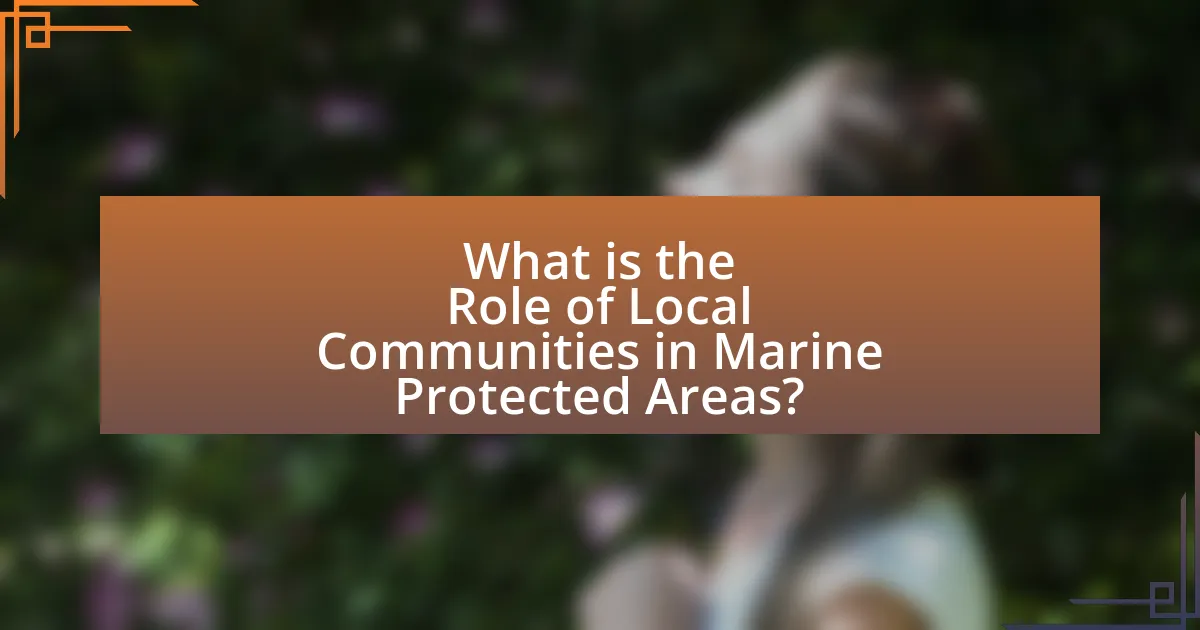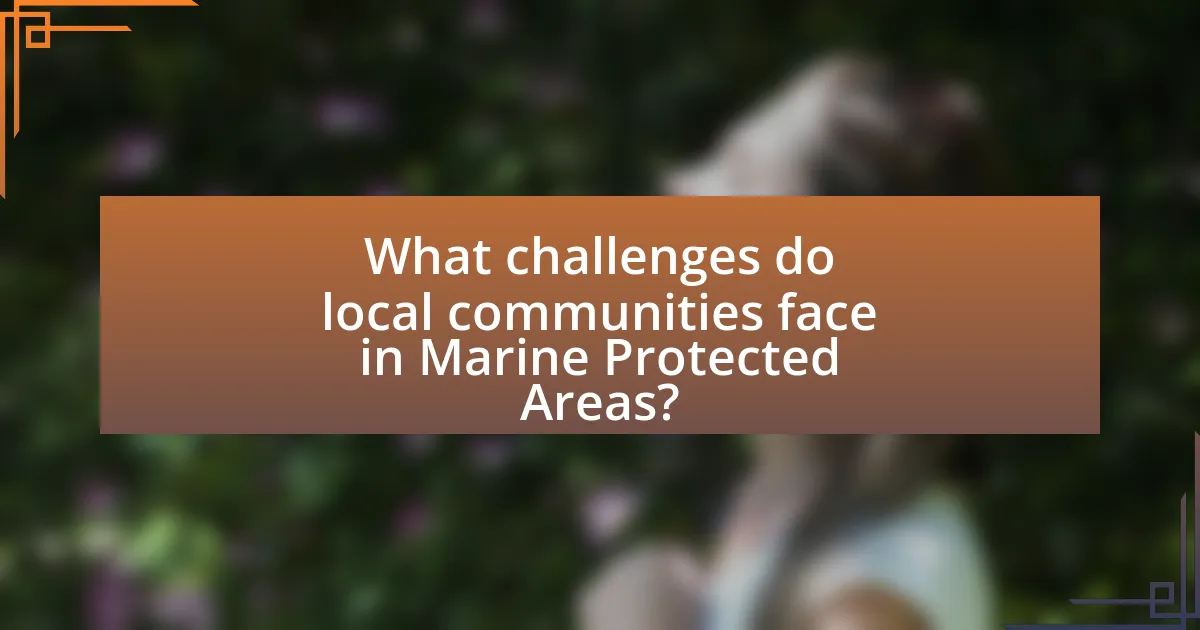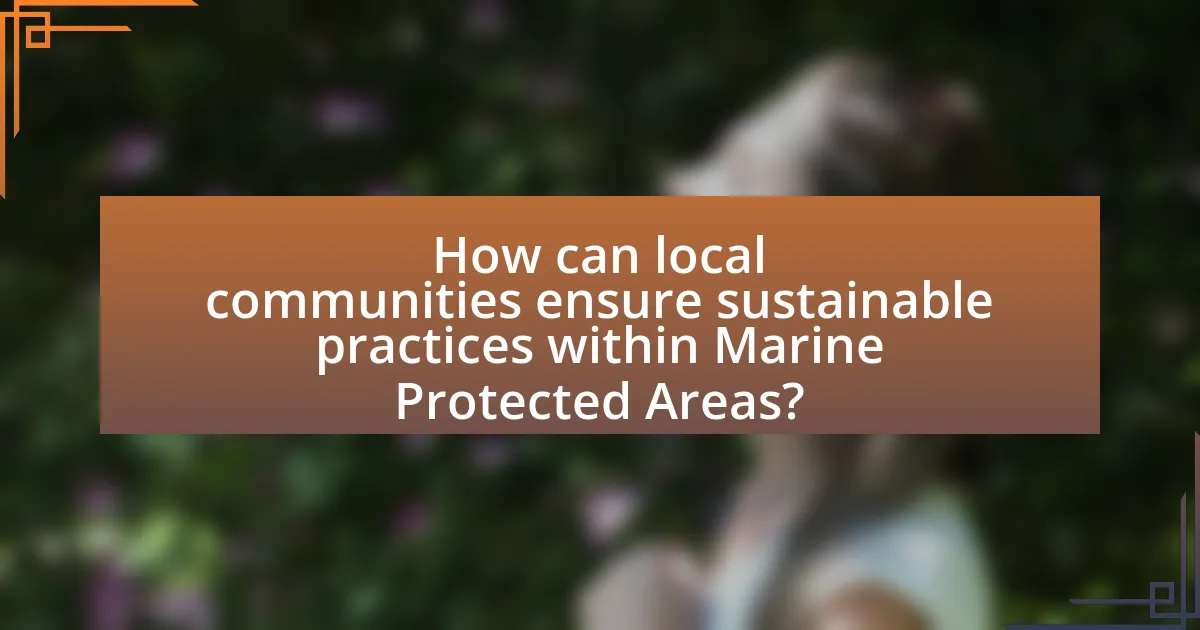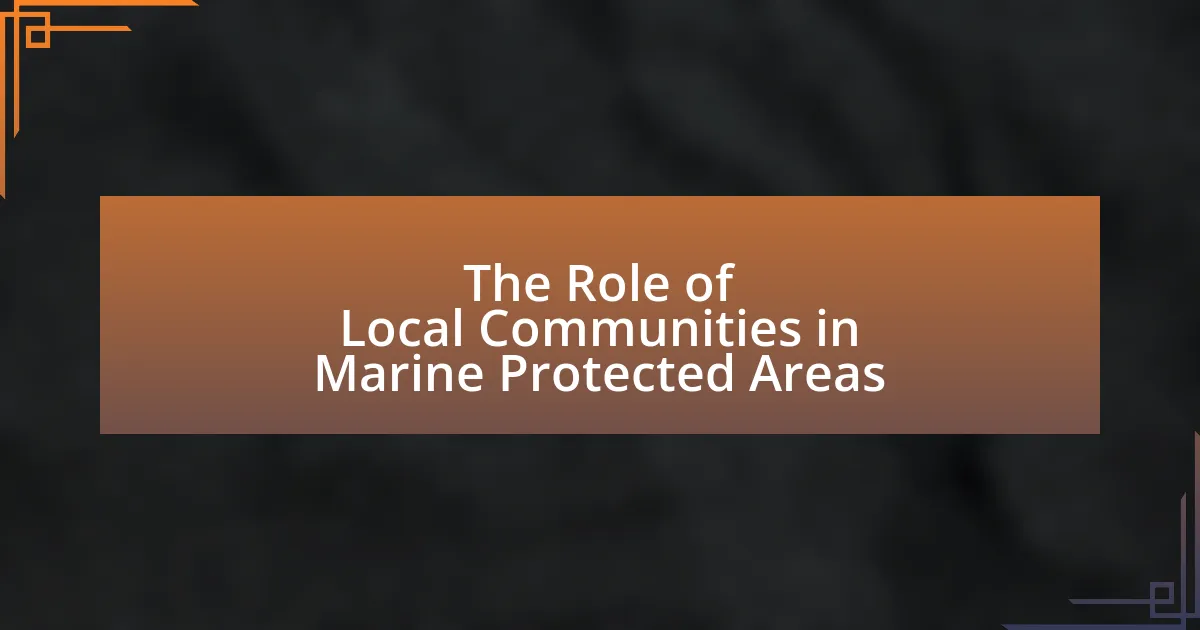Local communities are integral to the management and success of Marine Protected Areas (MPAs), contributing local knowledge, participating in decision-making, and ensuring sustainable practices. Their involvement leads to enhanced conservation outcomes, as evidenced by increased fish biomass and improved biodiversity in co-managed MPAs. The article explores the specific roles of local community members in conservation efforts, the benefits they gain from participation, and the challenges they face, including socio-economic factors and conflicts with conservation goals. It also discusses strategies for enhancing community engagement, the importance of traditional ecological knowledge, and successful community-led initiatives that demonstrate effective resource management within MPAs.

What is the Role of Local Communities in Marine Protected Areas?
Local communities play a crucial role in the management and success of Marine Protected Areas (MPAs) by contributing local knowledge, participating in decision-making, and ensuring sustainable practices. Their involvement enhances conservation efforts, as local residents often possess valuable insights into the marine ecosystem and its historical changes. Studies have shown that when communities are engaged in the governance of MPAs, compliance with regulations increases, leading to better ecological outcomes. For instance, a report by the World Wildlife Fund highlights that MPAs co-managed with local communities have shown a 30% increase in fish biomass compared to those managed without community involvement. This evidence underscores the importance of local communities in achieving the objectives of MPAs.
How do local communities contribute to the management of Marine Protected Areas?
Local communities contribute to the management of Marine Protected Areas (MPAs) by actively participating in decision-making processes, enforcing regulations, and engaging in sustainable practices. Their involvement ensures that local knowledge and cultural values are integrated into management strategies, which enhances the effectiveness of conservation efforts. For instance, studies have shown that community-led initiatives in MPAs often lead to improved biodiversity outcomes and increased compliance with regulations, as local stakeholders are more likely to adhere to rules they helped create. Additionally, local communities often monitor marine resources, providing valuable data that informs management decisions and helps adapt strategies to changing environmental conditions.
What specific roles do local community members play in conservation efforts?
Local community members play crucial roles in conservation efforts by participating in monitoring, enforcement, and education within Marine Protected Areas (MPAs). They often engage in data collection on marine biodiversity, which helps inform management decisions. For instance, community-led initiatives have been shown to increase compliance with conservation regulations, as local residents are more likely to enforce rules among their peers. Additionally, local communities contribute to awareness campaigns that educate both residents and visitors about the importance of marine conservation, fostering a culture of stewardship. Research indicates that when local communities are actively involved in conservation, such as in the case of the Tubbataha Reefs Natural Park in the Philippines, there is a significant increase in biodiversity and fish populations, demonstrating the effectiveness of community engagement in conservation efforts.
How does community involvement enhance the effectiveness of Marine Protected Areas?
Community involvement enhances the effectiveness of Marine Protected Areas (MPAs) by fostering local stewardship and compliance with conservation measures. When communities actively participate in the management and decision-making processes of MPAs, they are more likely to support and adhere to regulations, leading to better protection of marine ecosystems. Research indicates that areas with strong community engagement experience improved biodiversity outcomes and increased fish populations, as local stakeholders often have a vested interest in the health of their marine resources. For instance, a study published in “Conservation Biology” by Charles et al. (2016) found that MPAs co-managed with local communities showed a 30% increase in fish biomass compared to those without community involvement. This evidence underscores the critical role that local communities play in the success of MPAs.
Why are local communities essential for the success of Marine Protected Areas?
Local communities are essential for the success of Marine Protected Areas (MPAs) because they play a critical role in the stewardship and sustainable management of marine resources. Their involvement ensures that conservation efforts align with local knowledge, cultural practices, and economic needs, which enhances compliance and support for MPA regulations. Studies have shown that when local communities are engaged in the decision-making process, such as in the case of the Great Barrier Reef Marine Park, there is a significant increase in the effectiveness of conservation measures, leading to improved biodiversity outcomes and sustainable fisheries.
What benefits do local communities gain from participating in Marine Protected Areas?
Local communities gain economic, environmental, and social benefits from participating in Marine Protected Areas (MPAs). Economically, MPAs can enhance local fisheries by allowing fish populations to recover, leading to increased catches outside protected zones; studies show that fish biomass can increase by up to 600% in well-managed MPAs. Environmentally, local communities contribute to biodiversity conservation, which helps maintain ecosystem services that are vital for their livelihoods, such as clean water and coastal protection. Socially, participation in MPAs fosters community engagement and stewardship, empowering locals to manage their resources sustainably and enhancing their cultural identity linked to marine environments.
How does local knowledge influence the management of Marine Protected Areas?
Local knowledge significantly influences the management of Marine Protected Areas (MPAs) by providing insights into local ecosystems, species behavior, and historical fishing practices. This knowledge helps managers make informed decisions that align conservation efforts with community needs and practices. For instance, studies have shown that incorporating local ecological knowledge can enhance biodiversity outcomes and improve compliance with regulations, as local communities are more likely to support management strategies they helped develop. Research by the World Resources Institute indicates that MPAs co-managed with local communities often achieve better ecological and social outcomes compared to those managed solely by government entities.

What challenges do local communities face in Marine Protected Areas?
Local communities in Marine Protected Areas (MPAs) face significant challenges, including restricted access to traditional fishing grounds, which can lead to economic hardship. These restrictions often arise from conservation efforts aimed at preserving marine biodiversity, resulting in reduced livelihoods for local fishers. Additionally, communities may experience conflicts over resource management, as differing priorities between conservation goals and local needs can create tension. A study by the World Wildlife Fund highlights that over 60% of local fishers report negative impacts on their income due to MPA regulations. Furthermore, inadequate involvement in decision-making processes can lead to a lack of support for conservation initiatives, as local communities may feel alienated from the management of their resources.
How do socio-economic factors impact local community involvement?
Socio-economic factors significantly impact local community involvement by influencing the resources, motivations, and capacities of individuals to engage in community activities. Communities with higher income levels often have more access to education and information, which can lead to greater awareness and participation in initiatives related to marine protected areas. For instance, a study by the World Bank found that communities with better economic conditions are more likely to invest in sustainable practices and conservation efforts, as they can allocate funds and time towards these activities. Conversely, lower socio-economic status can limit access to resources, reducing community engagement and participation in decision-making processes regarding marine conservation.
What are the barriers to effective participation of local communities in Marine Protected Areas?
Barriers to effective participation of local communities in Marine Protected Areas include lack of awareness, insufficient access to information, and inadequate representation in decision-making processes. Many local communities are unaware of the benefits and regulations associated with Marine Protected Areas, which limits their engagement. Additionally, the absence of transparent communication channels hinders access to crucial information regarding conservation efforts. Furthermore, local communities often lack representation in governance structures, resulting in decisions that do not reflect their needs or knowledge. Studies indicate that these barriers can lead to conflicts and reduced compliance with conservation measures, ultimately undermining the effectiveness of Marine Protected Areas.
How can conflicts between conservation goals and community needs be resolved?
Conflicts between conservation goals and community needs can be resolved through collaborative management approaches that involve local communities in decision-making processes. Engaging communities ensures that their needs and knowledge are integrated into conservation strategies, fostering a sense of ownership and responsibility towards marine protected areas. For instance, studies have shown that co-management frameworks, where local stakeholders participate alongside government and conservation organizations, lead to more effective conservation outcomes and improved community livelihoods. Research by Berkes (2009) in “Evolution of Co-Management: Role of Local Knowledge” highlights that such partnerships can enhance both ecological sustainability and social equity, demonstrating that aligning conservation efforts with community interests is essential for long-term success.
What strategies can enhance local community engagement in Marine Protected Areas?
Strategies that can enhance local community engagement in Marine Protected Areas include participatory governance, education and awareness programs, and sustainable livelihood initiatives. Participatory governance allows community members to have a voice in decision-making processes, fostering a sense of ownership and responsibility towards marine conservation. Education and awareness programs, such as workshops and outreach activities, inform communities about the ecological and economic benefits of Marine Protected Areas, leading to increased support for conservation efforts. Sustainable livelihood initiatives, like eco-tourism and sustainable fishing practices, provide economic incentives for communities to engage in and support the protection of marine resources. Research indicates that when local communities are actively involved in management and benefit-sharing, conservation outcomes improve significantly, as seen in case studies from various Marine Protected Areas worldwide.
How can education and awareness programs improve community participation?
Education and awareness programs can significantly improve community participation by equipping individuals with knowledge about marine ecosystems and the importance of conservation. These programs foster a sense of ownership and responsibility towards local marine protected areas, encouraging community members to engage actively in conservation efforts. For instance, studies have shown that communities involved in educational initiatives are more likely to participate in sustainable practices, as evidenced by a report from the World Wildlife Fund, which found that communities with awareness programs saw a 30% increase in participation in local conservation activities. By enhancing understanding and promoting active involvement, education and awareness programs create a more informed and engaged community, leading to better outcomes for marine conservation efforts.
What role do partnerships between communities and organizations play in Marine Protected Areas?
Partnerships between communities and organizations play a crucial role in the effectiveness and sustainability of Marine Protected Areas (MPAs). These collaborations enhance local stewardship, ensuring that conservation efforts align with community needs and knowledge. For instance, studies have shown that when local communities are actively involved in the management of MPAs, compliance with regulations increases, leading to better ecological outcomes. A report by the World Wildlife Fund highlights that community-led initiatives in MPAs can lead to a 30% increase in fish biomass compared to areas without such partnerships. This evidence underscores the importance of integrating local perspectives and expertise into marine conservation strategies.

How can local communities ensure sustainable practices within Marine Protected Areas?
Local communities can ensure sustainable practices within Marine Protected Areas (MPAs) by actively participating in management decisions and implementing conservation initiatives. Engaging local stakeholders in the planning process fosters a sense of ownership and responsibility, which is crucial for the long-term success of MPAs. For instance, communities can establish local regulations that align with scientific guidelines, such as fishing quotas or seasonal closures, to protect marine biodiversity. Evidence from the Coral Triangle Initiative shows that community-led management has led to a 30% increase in fish biomass in areas where local governance is strong. By combining traditional ecological knowledge with modern conservation strategies, local communities can effectively contribute to the sustainability of MPAs.
What best practices can local communities adopt for sustainable resource management?
Local communities can adopt best practices for sustainable resource management by implementing community-based resource management strategies. These strategies involve local stakeholders in decision-making processes, ensuring that resource use aligns with ecological sustainability and community needs. For instance, the establishment of marine protected areas (MPAs) has been shown to enhance biodiversity and fish stocks, benefiting local fisheries. Research indicates that MPAs can lead to a 20-30% increase in fish populations within their boundaries, which supports both ecological health and local economies. Additionally, promoting sustainable fishing practices, such as catch limits and seasonal closures, helps maintain fish populations and habitats. Engaging in education and awareness programs about the importance of conservation can further empower communities to protect their resources effectively.
How can traditional ecological knowledge contribute to sustainable practices?
Traditional ecological knowledge (TEK) can significantly contribute to sustainable practices by providing insights into local ecosystems and resource management strategies that have been developed over generations. TEK encompasses the understanding and skills that indigenous and local communities possess regarding their environment, which often includes sustainable harvesting techniques, seasonal patterns, and biodiversity conservation methods. For instance, studies have shown that indigenous fishing practices, which are informed by TEK, can lead to healthier fish populations and more resilient marine ecosystems. Research published in the journal “Ecological Applications” highlights that integrating TEK with scientific approaches in marine protected areas can enhance conservation outcomes and promote sustainable use of resources. This synergy between traditional knowledge and modern science fosters adaptive management strategies that are culturally relevant and ecologically sound.
What are the examples of successful community-led initiatives in Marine Protected Areas?
Successful community-led initiatives in Marine Protected Areas (MPAs) include the establishment of the Apo Island Marine Reserve in the Philippines, where local fishermen collaborated to create a no-take zone, resulting in increased fish populations and biodiversity. Another example is the community-managed marine area in the Cook Islands, where local communities implemented sustainable fishing practices, leading to improved marine health and economic benefits. Additionally, the community-led conservation efforts in the Great Barrier Reef, Australia, have involved Indigenous groups in managing marine resources, enhancing both ecological and cultural outcomes. These initiatives demonstrate the effectiveness of local community involvement in the sustainable management of marine ecosystems.
What practical steps can local communities take to advocate for their interests in Marine Protected Areas?
Local communities can advocate for their interests in Marine Protected Areas (MPAs) by organizing grassroots campaigns to raise awareness and influence policy decisions. These campaigns can include public meetings, workshops, and collaboration with local stakeholders to gather support and share knowledge about the ecological and economic benefits of MPAs. Engaging in participatory research allows communities to collect data that supports their claims, demonstrating the importance of local fishing practices and biodiversity conservation. Additionally, forming partnerships with environmental organizations can amplify their voice and provide resources for advocacy efforts. Evidence shows that communities actively involved in MPA management often experience better conservation outcomes and sustainable use of marine resources, as seen in case studies from the Philippines and the Caribbean.
How can local communities effectively communicate their needs to policymakers?
Local communities can effectively communicate their needs to policymakers by organizing structured dialogues and utilizing data-driven advocacy. Structured dialogues, such as community forums or workshops, allow residents to articulate their concerns and priorities directly to decision-makers. For instance, the Coastal Communities Network in the UK has successfully engaged local stakeholders in discussions about marine conservation, leading to more informed policy decisions. Additionally, presenting data on local environmental conditions, economic impacts, and social dynamics can strengthen the case for specific needs. Research shows that communities that provide empirical evidence alongside their narratives are more likely to influence policy outcomes, as seen in the case of the Gulf of Maine Council, where local data on fisheries management led to significant policy changes.
What resources are available to support local communities in Marine Protected Areas?
Local communities in Marine Protected Areas (MPAs) can access various resources, including financial support, educational programs, and technical assistance. Financial resources often come from government grants, non-governmental organizations, and international funding bodies aimed at conservation efforts, which can total millions of dollars annually. Educational programs provide training on sustainable fishing practices and marine conservation, enhancing community knowledge and engagement. Technical assistance includes guidance on best practices for resource management and habitat restoration, often facilitated by partnerships with research institutions and conservation organizations. These resources collectively empower local communities to actively participate in the stewardship of marine ecosystems while promoting sustainable livelihoods.
